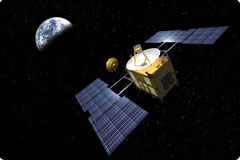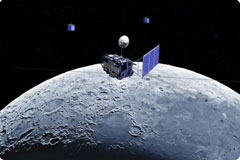We would like to introduce JAXA's past exploration missions to the moon and planets in the solar system.



Halley 's Comet Explorer "SUISEI" (PLANET-A)
The "SUISEI" is a planet explorer with the aim of observing Halley's Comet, which came close to Earth for the first time in 76 years. On August 19, 1985, the explorer was launched by M-3SII rocket #2 from the Kagoshima Space Center in Uchinoura. On March 8, 1986, the SUISEI approached to about 150,000 km from the Comet to observe the Comet's coma (hydrogen gas clouds) and tail gas. After that, the SUISEI continued observations of solar wind, then, on August 20, 1992, the final earth swing-by was conducted to complete the mission.
Mars Explorer "NOZOMI" (PLANET-B)

NOZOMI (PLANET-B) was Japan's first Mars explorer and its main mission was to research the upper atmosphere of Mars by focusing on the interaction with solar wind. On July 4, 1998, the explorer was launched by M-V-3 rocket from the Kagoshima Space Center in Uchinoura. On the way to Mars, however, trouble occurred with NOZOMI and substantial orbit changes were made. It finally approached Mars in December 2003, four years behind the original plan. Due to frequent problems, however, the systems required to enter orbit around Mars did not work. Despite of every possible effort to restore the functions, we had to abandon insertion of the explorer into the orbit of Mars on December 9, 2003, as we were not able to operate the necessary equipment. NOZOMI has become an artificial planet that flies forever in orbit around the Sun near Mars.
Asteroid Explore "HAYABUSA" (MUSES-C)

HAYABUSA (MUSES-C) has been developed to investigate a small asteroid. HAYABUSA explored the asteroid named "Itokawa," after the late Dr. Hideo Itokawa, the father of Japan's space development program. The Itokawa has a similar orbit as that of the earth. The purpose of the HAYABUSA mission is to capture a material sample of the Itokawa and return it to Earth by traveling through space using an ion engine and arriving at the asteroid autonomously. By establishing technology to collect a sample from an asteroid and return it to Earth, we can learn about the raw materials that make up planets and asteroids and about the state of the inside of a solar nebula around the time of the birth of the planets. Even if the sample amount is small, its scientific significance is tremendous as it can be analyzed on the Earth. HAYABUSA, which was launched on May 9, 2003, achieved its goal of arriving at the Itokawa asteroid and performing scientific observations. As a result, its mission was featured in the magazine "Science" as the first Japanese mission to illustrate various new findings about the asteroid including its gravity and surface conditions. HAYABUSA is now under preparations for its return trip to the Earth in 2010.
SELenological and ENgineering Explorer "KAGUYA" (SELENE)

- SELenological and ENgineering Explorer "KAGUYA" (SELENE)
- KAGUYA (SELENE) Project site
- KAGUYA Data Archives
- KAGUYA 3D GIS
- KAGUYA Image Gallery
The SELenological and ENgineering Explorer "KAGUYA" (SELENE), Japan's first large lunar explorer, was launched by the H-IIA rocket on September 14, 2007 (JST). The mission, which was the largest lunar mission since the Apollo program, was being keenly anticipated by many countries.
KAGUYA investigated the entire moon in order to obtain information on its elemental and mineralogical composition, its geography, its surface and sub-surface structure, the remnant of its magnetic field, and its gravity field. The results are expected to lead to a better overall understanding of the Moon's evolution. At the same time, the observation equipment installed on the orbiting satellite will observe plasma, the electromagnetic field and high-energy particles. The data obtained in this way will be of great scientific importance for exploring the possibility of using the moon for human endeavors.
The KAGUYA was maneuvered to be dropped around 80.5 degrees east longitude and 65.5 degrees south latitude onto the Moon on June 11, 2009.
The observation data process and calibration operations are still underway, and the data will be offered to the general public.
KAGUYA investigated the entire moon in order to obtain information on its elemental and mineralogical composition, its geography, its surface and sub-surface structure, the remnant of its magnetic field, and its gravity field. The results are expected to lead to a better overall understanding of the Moon's evolution. At the same time, the observation equipment installed on the orbiting satellite will observe plasma, the electromagnetic field and high-energy particles. The data obtained in this way will be of great scientific importance for exploring the possibility of using the moon for human endeavors.
The KAGUYA was maneuvered to be dropped around 80.5 degrees east longitude and 65.5 degrees south latitude onto the Moon on June 11, 2009.
The observation data process and calibration operations are still underway, and the data will be offered to the general public.

